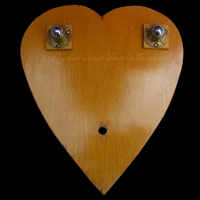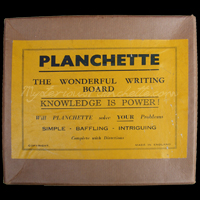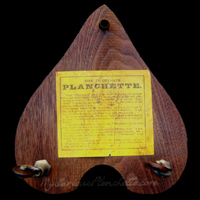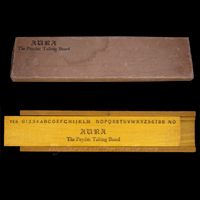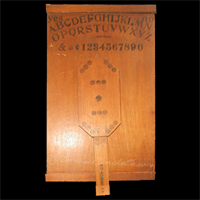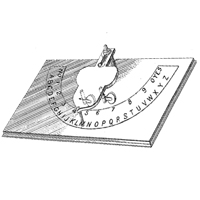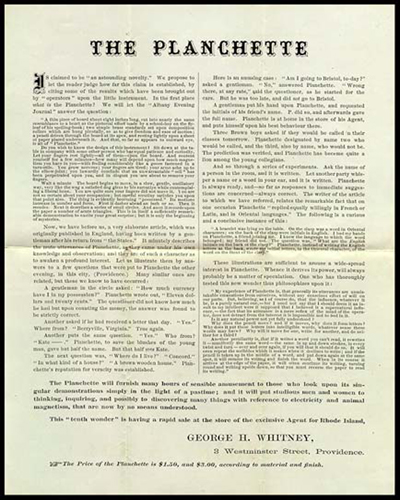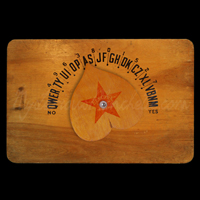Every once in a while, we discover a planchette or dial plate we can't identify. Few planchettes are stamped with a maker's mark, and though many have paper bookplates that sometimes identify their maker, we occasionally find a lone specimen with mark or box that we can't positively assign a pedigree. In other cases, like British Manufacture planchettes, we can make links between some boards' similarities and accurately categorize them, but rely on some breakthrough like a single box with the "Glevum Games" moniker to finally ID a family. In others still, we only have a paper trail, and have to reconstruct what we know through advertisements, trade circulars, or newspaper reports.
The nature of planchette manufacturers, whether they be toy makers or scientific instrument firms, often obscures a plank's true source. "Jobbing" was common, with one firm making a box, another making the castors or cutting the boards, and yet another putting it all together, possibly even for a fourth party to brand with their company name or logo. The ravages of time on company archives and the often temporary nature of many of those firms that sprung up with the planchette crazes and died along with the fads ensures that we may never know more about some companies than their name and hints of when they flourished. Some firms, too, seemed reluctant to assign their name to a potentially controversial topic, and even today some still existing toy companies don't seem to want to discuss that their forebears ever had anything to do with spirit communication devices.
In some cases, we have everything in one place, but still can't ID a board. Such is the case of this "yellow label" board recently discovered in England. We have everything we normally need to accurately place the board, yet it remains elusive, with no help from the "Made in England" stamp or incredibly vague "Copyright.". "Knowledge is Power," indeed. The bright yellow box label reminds us of similar H.P. Gibson & Sons boxes, and the brass ball-bearing castors have the same thick, squat appearance as those used by the Metaphysical Research Group boards, which may very well be secondary uses of ball-bearing door latches. The shape is classically heart-shaped, hearkening back to American boards, and overall the quality is just so-so. Indeed, it almost feels like some bootleg copy of higher-quality boards.
What is it with yellow labels and mystery planks? We have affectionately dubbed this board the "Kirby Clone" for its distinctive rear cut-out that hearkens back to those famous boards. Like the unknown English plank above, this board almost seems like some weird old bootleg, with its bright yellow label's bold font and almost "whittled" nose shape. But it is a beautiful board, with nicely-cast pot-metal castors and gorgeous wooden wheels. Like most mystery planks, we don't know if this board was manufactured about the same time as Kirby's, to take advantage of the company's big market push, or many decades later. Perhaps another boxed specimen will show up to lead the way!
Another enigma is the Aura "Psychic Talking Board." Obviously similar to Milton Bradley's 1895 "Genii" board, we don't know anything about this one beyond what the few surviving specimens tell us, which is basically its name. The Aura falls into the dial plate category. Crafted of maple, its slide rule-type faceplate is emblazoned with its name, as well as the standard communications found on most talking boards, including "Yes," "No," the alphabet, and the numbers 0-9. Simple in operation, the faceplate simply slides back and forth within the outer wooden frame without the use of ball-bearings, a simple arrow spelling out messages from beyond. Weeks of research in the collector community has failed to turn up a single scrap of this board's maker, though we suspect it was constructed to capitalize on the ouija board craze of the 1890s, and copied the Genii board pretty darn closely. We can only hope more evidence shows up!
Straddling the line between ouija boards and dial plates is this unique board, sold years ago at auction after being discovered at an East Coast flea market. It is undoubtedly a very early board, and its stenciled markings and starburst embellishments hint that is was manufactured, not homemade. It is a beautiful board in a rare vertical form. Like most dial plates, it would be operated with the user's hands on the planchette board, which freely moves around the board despite being secured to it, thanks to its arm's slotted design that enables movement not only side-to-side, but also along a vertical axis. The "captured planchette" design is most reminiscent of Charles Kennard's 1891 talking board patent, which utilizes a similar mechanic for a one-piece device. Is this board somehow related? Only time will tell, but for now, our well of research has run dry on this interesting talking board.
In 1891, Charles Kennard, self-proclaimed "inventor" of the ouija board, was ousted from the eponymous company he founded after he sold rights to his talking board patent back to the company. Perhaps forecasting his short future with his company, Kennard patented a new talking board just prior to his ouster. While Kennard would attempt to recapture his initial success with the "Volo" board in 1892 through his new company, and later the "Igili" board in 1897, it is his new patent that intrigues us. This design utilizes a "captured planchette" mechanism, with a wheeled planchette literally attached to the board by a swinging lever that could move in a two-tiered arch to spell out messages. It is unknown if Kennard ever produced these boards through his new Northwestern Toy & Manufacturing Company, but this tantalizing clue keeps us on our toes and ever on the lookout for Kennard's elusive lost board.
Other boards we only know of through their paperwork. Such is the case with the possible George Whitney planchette. Like most firms that produced early planchettes, George Whitney was a publisher and bookseller in a large, prosperous store at No. 3 Westminster Street in Providence, Rhode Island. Whitney sold his store and left the business in 1874, so we know anything with his name on it dates from before then, and such is the most likely case with the intriguing evidence we have of his foray into the world of planchettes! The only clue we have that Whitney may have produced a planchette is a trade circular put out by his company advertising the board's availability. Promoting this "astonishing novelty" and including references to the "Once a Week" article and other news stories of the day, the flyer goes on to note the rising regional craze for the planchette, and we are confident dating the circular to the First Great Craze of 1868 as a result. The only question that remains is whether this flyer represents a planchette made by the bookseller himself, or if he was simple acting as the Rhode Island agent for another manufacturer's board, such as the Boston Planchette or the Kirby. All we know for now is that the planks sold for $1.50-3.00 "according to material and finish." We hope to see an original Whitney board turn up.
Some companies grace us with their name, but little else. Such is the case with the dial plate boards produced by the Electra Company of Portland, Maine. Collectors had long suspected the existence of board based on Donelly's July 4, 1923 patent, and this was confirmed in 2000 when an Art-Nouveau styled model appeared in a collectibles publication. That board's label only deepened the mystery, with a picture of a similar, less fanciful board that took us until last year to score an elusive picture of via a generous Etsy seller. Information obtained on another specimen by the Museum of Talking Boards indicates that a Philadelphia, PA company by the name of Dirigo produced the boards as well, only adding to the confusion, as we can't seem to pry information on either company out of our archives. No doubt more time and effort will finally reveal the factories and personalities behind these elusive manufacturers.
The final mystery plank is again only known through a print advertisement. Like many planchettes of the First Great Craze, it was offered by a popular stationer, in this case the firm Brown, Watkins & Shaw, of 42 John Street, New York. The stationer existed for 6 years, when James Theron Watkins, who had been employed at the Olney Pratt & Co stationer in the same neighborhood, left to form his own business right across the street. The year after the planchette craze, the firm dissolved, and Watkins returned to his former employment, and eventually became a well-known traveling pencil salesman.
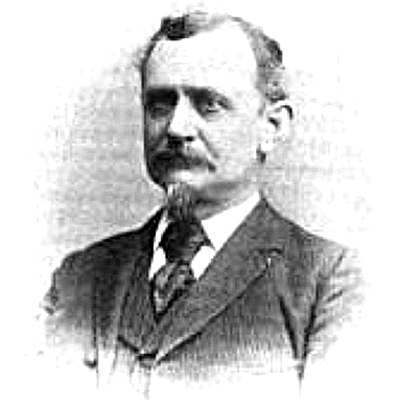
James Theron Watkins, founder of Brown, Watkins & Shaw stationers, who produced Fountain's "Improved Planchette."
We know little of the planchette itself, or even why it was called Fountain's, though this may be a reference to its inventor. It was, as others of its kind, touted as the most wonderful parlor amusement of the age, and extolled the plank's virtue of magneto-electric influence or mind over matter. As an American planchette, it is likely heart-shaped in the vein of a Kirby or Boston planchette. If you have any information on the identity of this planchette, let us know!







